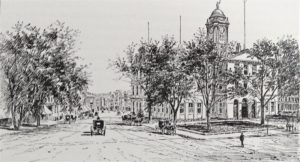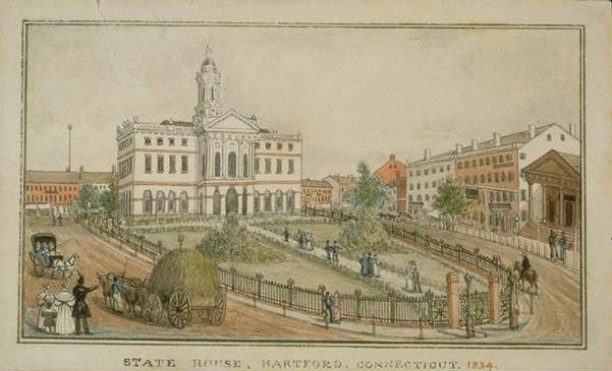By Elizabeth Correia
Connecticut’s Old State House in Hartford held its first legislative session on May 11, 1796. Over the next 82 years it served as the center of Connecticut’s legislative activities–a place where government officials debated some of the most consequential court cases and political policies in American history. The building then served as Hartford’s city hall and remained an active government facility until 1915. Throughout much of the 20th century, however, disuse threatened the structure, but the Connecticut Historical Society’s revitalization efforts allowed it to open as a museum in 1961, at which time it also became a National Historic Landmark.
The Building in Hartford
The Connecticut General Assembly ordered the construction of a new state house in 1792 to replace the original 1719 wood-frame building that once stood on the same property. Master Builder John Leffingwell completed the new statehouse, now known as “Connecticut’s Old State House,” in 1796 using the Neoclassical designs of Boston architect Charles Bulfinch. The building originally sported three stories of brownstone and brick. Space for the Senate, House of Representatives, courts, the governor, comptroller, treasurer, secretary of the state, and the school fund occupied the first floor, and committee rooms resided on the second. Portraitist Rev. Joseph Steward located his painting room (and eventually his Museum of Natural and Other Curiosities) on the third floor.

A sketch of the Old State House, ca. 1886 – Trumbull, J. Hammond, ed. The Memorial History of Hartford County Connecticut 1633-1884, Vol. 1. Boston: Edward L. Osgood Publishers, 1886.
After 1878, the state house ceased to be the state capitol but found new life as Hartford City Hall. In the early 20th century, after Hartford’s construction of a new city hall, the Old State House became vacant and remained so for long periods–only used sporadically as a community center for the Red Cross and other local groups.
In 1961, the Connecticut Historical Society saved the Old State House from demolition by opening exhibition galleries inside. The Old State House Association restored the building in the 1990s and Connecticut’s Old State House remains a public museum to this day.
The Old State House on a National Stage
The Old State House was where all of Connecticut’s most important legislative debates took place between 1796 and 1878. One such debate was the case against Prudence Crandall and her academy for young black women. The state eventually convicted Crandall of violating its Black Law, which prohibited the education of black students from out of state. Ultimately, the higher court overturned this decision and Crandall’s story went on to spark national debate. Lawyers cited her case for decades when arguing for equal rights to education, as they did in Brown v. the Board of Education.

Old State House (City Hall) and junction of Main Street and Central Row, Hartford (1911) – Connecticut Historical Society
In 1815, the Hartford Convention met secretly at the Old State House to oppose U.S. involvement in the War of 1812 and to seek protection for New England’s commercial interests. Representatives from five states debated ways to avoid a local economic crisis and even floated the idea of seceding from the Union. More than two decades later, in 1839, the first trial for the rebels of the Cuban schooner Amistad took place in the Old State House. The judge ultimately ruled that the enslaved Africans were born free men and that the slave hunters had illegally captured them. This ruling gave hope to abolitionists in the United States that further successes might be achieved through legal actions.
In 1870, Isabella Beecher Hooker, founder of the Connecticut Women’s Suffrage Association, arrived at the Old State House to petition the general assembly for women’s rights to own property. After seven years of battling, she won the case and joined suffragists from across America in fighting for property rights in their states.
Today, the programming at Connecticut’s Old State House actively engages the public in civil discourse. The organization’s mission is a tribute to its role as a center for debating the issues that helped shape Connecticut during the nation’s most formative years.
Elizabeth Correia holds an MA degree in Public History from Central Connecticut State University and works in cultural resource management.








